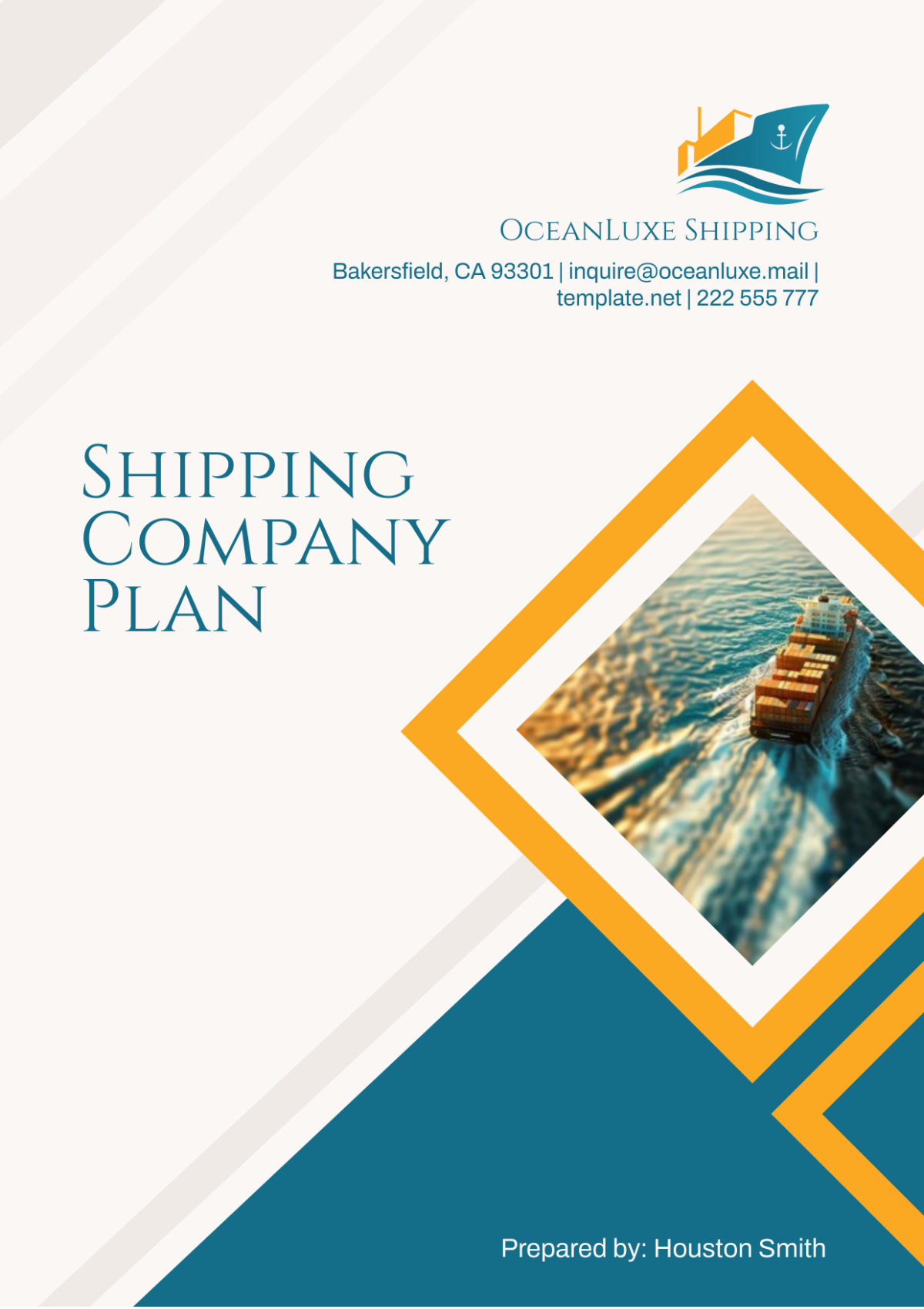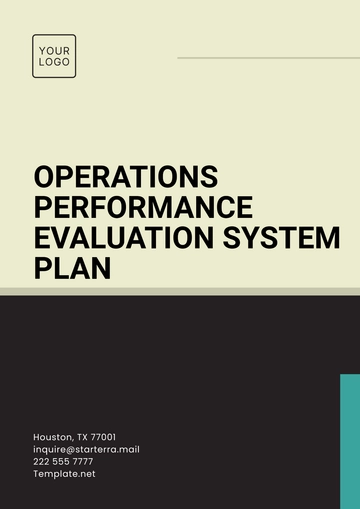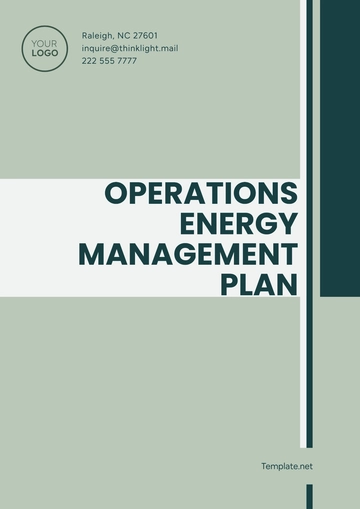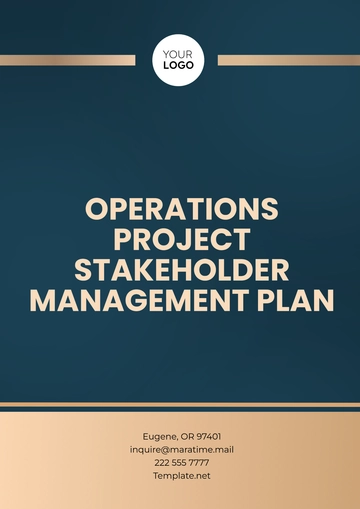Free Shipping Company Plan

1. Executive Summary
1.1 Company Overview
[Your Company Name] is a leading global shipping company, built on a foundation of innovation, operational excellence, and an unwavering commitment to sustainability. We provide shipping services that cater to industries worldwide, facilitating the smooth movement of goods across international borders. Our operations span across various sectors, from container shipping to bulk commodities, and we are driven by a strong customer-centric approach. Our strategy focuses on continuous fleet expansion, technological advancement, and global market reach. As we look towards 2065, [Your Company Name] aims to become a dominant player in the shipping industry, leveraging cutting-edge technologies and sustainable practices to meet the growing demands of global trade.
1.2 Mission and Vision
Mission:
Our mission is to deliver sustainable, safe, and timely shipping solutions that meet the evolving needs of our customers, ensuring the seamless movement of goods while maintaining operational efficiency and environmental responsibility. We strive to create value for all stakeholders through innovation, cost-effective services, and a focus on safety and quality.
Vision:
Our vision is to become the world's most trusted and innovative shipping company by [2050], setting new industry standards through advanced technology, sustainability, and superior customer service. We are committed to continuously improving our services to meet the dynamic needs of global trade and positioning ourselves as a leader in the shipping industry.
1.3 Business Objectives
[Your Company Name] has outlined ambitious business objectives to guide our strategic growth:
Achieve a market share of [30]% in the global shipping industry by [2060], positioning ourselves as a dominant player in the sector.
Expand our fleet size by [50]% over the next [15] years, ensuring we have the capacity to meet increasing demand for shipping services.
Adopt green technologies to reduce our carbon footprint, aiming for a [40]% reduction in emissions by [2070] through the use of cleaner fuels, energy-efficient ships, and sustainable port operations.
Increase annual revenue to over [$10 billion] by [2055], driven by fleet expansion, new market penetration, and enhanced service offerings.
Establish a fully automated and digitally integrated logistics operation by [2065], significantly improving efficiency and reducing human error in our operations.
1.4 Key Performance Indicators (KPIs)
Key Performance Indicators (KPIs) will be monitored regularly to measure progress toward achieving our goals. These KPIs include:
Fleet Utilization Rate: Maintain a fleet utilization rate of over [85]% each year to maximize efficiency and profitability across all shipping routes.
Customer Satisfaction: Achieve a customer satisfaction score of [90]% or higher, through regular surveys, follow-up with clients, and constant improvements to service delivery.
On-Time Delivery: Ensure [95]% on-time delivery for all shipments globally, ensuring our reputation for reliability and minimizing delays for customers.
Revenue Growth: Achieve consistent revenue growth of [10]% year-on-year, by expanding our service offerings, entering new markets, and increasing operational efficiency.
Sustainability Goals: Reach a [20]% reduction in fuel consumption per ton-mile by [2060], supporting our efforts to reduce the environmental impact of global shipping operations.
2. Market Analysis
2.1 Industry Overview
The global shipping industry is a vital component of the world’s economy, facilitating the movement of goods between countries and across continents. By [2065], the global shipping market is expected to grow by [3]% annually, driven by the increasing volume of trade, the rise in consumer demand for goods, and the continuous evolution of logistics technology. The market is projected to be worth [$1.7 trillion] by [2065], making it one of the most lucrative sectors globally. Shipping companies will face challenges such as rising fuel prices, stricter environmental regulations, and geopolitical instability, but there will also be immense opportunities for growth through digitalization, automation, and sustainability initiatives.
Year | Global Shipping Market Size ($ Billion) |
|---|---|
2050 | 800 |
2055 | 1,000 |
2060 | 1,300 |
2070 | 1,700 |
2.2 Target Market
Our target market is diverse, covering industries that require reliable and efficient shipping solutions. The primary industries we serve include:
Retail and E-Commerce: The demand for global shipping is increasing as e-commerce continues to grow. Companies require fast and reliable shipping for consumer goods, often with specialized needs for high-value items, temperature-sensitive products, and perishable goods.
Manufacturing: Companies involved in the production of goods, from raw materials to finished products, need dependable shipping services to transport materials across regions and deliver products to international markets.
Energy and Resources: Shipping of bulk commodities, such as oil, gas, and renewable energy components like solar panels and wind turbines, is a major focus for our company. This market has seen significant growth with the rise of renewable energy projects worldwide.
Agriculture: Agriculture requires global shipping for perishable goods, such as fruits, vegetables, and grains. With a focus on refrigeration and timely delivery, this segment represents a critical component of global food distribution.
Automotive: The automotive industry demands reliable logistics for transporting vehicles, parts, and accessories between manufacturers, suppliers, and retailers worldwide.
2.3 Competitive Landscape
The shipping industry is competitive, with major players like Maersk, MSC, and CMA CGM holding large portions of the market. These companies dominate international trade routes with a large fleet and a vast network of ports and terminals. However, there is also room for growth in niche markets, especially as customer demand for sustainability, specialized shipping services, and digital solutions continues to increase. Smaller companies focusing on eco-friendly solutions, automation, and customer personalization can carve out profitable niches in this competitive environment. [Your Company Name] intends to leverage advanced technologies and its customer-first approach to differentiate itself and compete against the industry giants.
2.4 SWOT Analysis
Strengths | Weaknesses |
|---|---|
Strong global network | High capital investment required |
Efficient fleet and infrastructure | Vulnerability to fuel price volatility |
Advanced technology integration | Dependence on international regulations |
Established reputation | Potential operational challenges with fleet expansion |
Opportunities | Threats |
|---|---|
Growth in global trade | Environmental regulations |
Expansion into emerging markets | Geopolitical instability |
Automation and digitization | Intense competition from larger players |
Adoption of eco-friendly shipping | Fluctuations in demand due to economic downturns |
3. Services and Operations
3.1 Shipping Services Offered
[Your Company Name] offers a wide variety of services designed to meet the needs of a diverse client base:
Container Shipping: We provide container shipping services for businesses moving both large and small quantities of goods. We handle both Full Container Load (FCL) and Less Than Container Load (LCL) shipments, providing flexible options for customers.
Bulk Shipping: This service involves the transportation of large quantities of loose commodities, such as coal, iron ore, and grains. It requires specialized vessels capable of carrying bulk goods, ensuring safe and efficient transport.
Reefer Shipping: For industries that require temperature-controlled environments, such as food, pharmaceuticals, and chemicals, our reefer shipping service offers state-of-the-art refrigerated containers that maintain optimal conditions during transport.
Ro-Ro Shipping: Our Roll-on/Roll-off service is designed for transporting vehicles, heavy machinery, and other large, wheeled cargo. This service is essential for industries like automotive manufacturing and construction.
Project Cargo: We specialize in the transport of oversized and complex shipments, such as industrial machinery, energy infrastructure, and large equipment. These shipments often require customized shipping solutions, including special permits and coordination with ports and terminals.
3.2 Operations and Logistics
Our operations are optimized to provide the most efficient and reliable services to our customers. We implement advanced software solutions for route planning, cargo tracking, and fleet management. We use automated systems at our major ports to streamline cargo loading and unloading, reducing turnaround times. We also collaborate closely with customs authorities worldwide to ensure that all international shipping regulations are met, minimizing delays and disruptions.
Route Optimization: Using AI-based tools, we optimize shipping routes to reduce fuel consumption and minimize delivery times, taking into account weather patterns, port congestion, and geopolitical factors.
Warehouse Management: Our state-of-the-art warehouses are strategically located at major ports around the world, ensuring quick transfer of goods and providing storage options for goods in transit.
Cargo Tracking: We offer customers real-time cargo tracking capabilities, ensuring full transparency throughout the shipping process. Our tracking system integrates seamlessly with our clients’ supply chain systems.
3.3 Fleet and Infrastructure
Our fleet consists of various vessels, including container ships, bulk carriers, and tankers, all designed to meet the highest industry standards in terms of fuel efficiency, safety, and environmental performance. The fleet is constantly updated, with regular investments in new ships equipped with the latest technologies.
Ship Types:
Container ships: [300] vessels with capacities ranging from [5,000] TEU to [15,000] TEU.
Bulk carriers: [100] vessels specialized in carrying dry bulk goods.
Oil tankers: [40] vessels for transporting liquid commodities.
We are continuously investing in upgrading our fleet to ensure operational efficiency and reduce environmental impact.
3.4 Technology and Innovation
At [Your Company Name], technology plays a central role in optimizing our shipping services and operations. We utilize artificial intelligence (AI) and machine learning to improve fleet management, route planning, and predictive maintenance. Our smart ships are equipped with IoT sensors that monitor vessel performance in real time, enabling predictive maintenance and reducing downtime. Additionally, we have incorporated blockchain technology into our logistics operations to improve the transparency and security of cargo transactions.
4. Marketing and Sales Strategy
4.1 Marketing Plan
Our marketing strategy is based on a multi-channel approach that emphasizes the strengths of [Your Company Name] in providing reliable, sustainable, and customer-focused shipping solutions. The plan includes:
Digital Marketing: Investing in SEO, content marketing, and online advertising to increase visibility and attract new clients, especially in emerging markets.
Branding and Positioning: Positioning [Your Company Name] as an environmentally-conscious and technology-driven brand that offers premium services.
Customer Outreach: Building relationships with key customers and stakeholders through personalized communication, events, and customer loyalty programs.
4.2 Sales Plan
Our sales strategy is focused on increasing market share by diversifying our service offerings, exploring new markets, and providing tailored solutions to meet unique customer needs. Sales will be driven by:
Dedicated Sales Teams: Focused on key industries, including retail, automotive, energy, and agriculture, to build long-term relationships and drive repeat business.
Partnerships and Alliances: We will form strategic partnerships with logistics providers and freight forwarders to expand our service offerings and improve market penetration.
4.3 Customer Service Strategy
Customer satisfaction is at the heart of our operations, and we have implemented a customer service strategy that focuses on responsiveness, personalized service, and reliability. We will:
24/7 Support: Offer round-the-clock customer support through multiple channels, including phone, email, and chat.
Feedback Mechanism: Regularly collect customer feedback to identify areas for improvement and enhance service offerings.
Client Education: Provide our customers with resources, such as webinars and guides, to help them understand the shipping process and optimize their logistics operations.
5. Financial Plan
5.1 Revenue Projections
Revenue growth for [Your Company Name] is projected as follows:
Year | Revenue ($ Billion) |
|---|---|
2050 | 4.5 |
2055 | 6.0 |
2060 | 8.5 |
2065 | 12.0 |
These projections are based on increased demand in global trade, continued fleet expansion, and market diversification. The growing demand for logistics services in developing regions and technological advancements are key drivers of this growth.
5.2 Operational Costs
Our operational costs will primarily consist of the following:
Fuel and Maintenance: Estimated at [40]% of total expenses.
Labor Costs: Estimated at [25]% of total expenses, considering wages, benefits, and training.
Port Fees: Estimated at [15]% of total expenses, covering docking, loading, and unloading charges.
Technology and Infrastructure: Estimated at [10]% of total expenses, covering investments in ships, equipment, and IT systems.
5.3 Profitability and Financial Strategy
We plan to maintain a profit margin of at least [10]% by improving operational efficiency, expanding high-margin services, and leveraging automation. Long-term profitability will also be driven by the global expansion of our operations.
5.4 Investment and Funding
We aim to raise [$2 billion] in the next [5] years through a combination of equity funding, bank loans, and reinvested profits. These funds will be used for fleet expansion, port facility upgrades, and investment in technology.
6. Risk Management
6.1 Risk Identification
The shipping industry is exposed to various risks, including:
Geopolitical Instability: Trade restrictions, tariffs, and conflicts can disrupt shipping routes.
Environmental Regulations: Stricter emissions regulations can increase operational costs.
Natural Disasters: Storms, floods, and earthquakes can damage infrastructure and disrupt services.
Cybersecurity Threats: Increasing reliance on digital systems exposes the company to data breaches and hacking attempts.
6.2 Risk Mitigation Strategies
To mitigate these risks, we have developed the following strategies:
Diversified Routes: By maintaining multiple shipping routes, we reduce the impact of disruptions in any single region.
Sustainability Initiatives: We invest in green technologies and comply with international environmental standards.
Disaster Recovery Plans: Robust disaster recovery protocols ensure continuity of service in the event of natural disasters.
Cybersecurity Investments: Ongoing investments in cybersecurity and regular system audits minimize the risk of data breaches.
6.3 Insurance and Compliance
[Your Company Name] ensures full compliance with international shipping regulations, including IMO standards, customs regulations, and environmental laws. Comprehensive insurance coverage is in place to protect cargo, vessels, and personnel, ensuring we can quickly recover from any incident.
7. Conclusion
[Your Company Name] is positioned to become a leading player in the global shipping industry by 2065. With a focus on technological innovation, sustainability, and customer satisfaction, we are committed to meeting the evolving needs of global trade. Our comprehensive plan for growth, efficiency, and risk management will allow us to navigate the challenges of the shipping industry and achieve long-term success. Through our strategic investments, continuous innovation, and exceptional customer service, [Your Company Name] will set the stage for a prosperous future in the shipping industry.
- 100% Customizable, free editor
- Access 1 Million+ Templates, photo’s & graphics
- Download or share as a template
- Click and replace photos, graphics, text, backgrounds
- Resize, crop, AI write & more
- Access advanced editor
Organize your shipping operations with the Shipping Company Plan Template from Template.net. This editable and customizable plan includes logistics strategies, budgeting, and timelines. Adjust it in our Ai Editor Tool to create an effective plan for your shipping business.
You may also like
- Finance Plan
- Construction Plan
- Sales Plan
- Development Plan
- Career Plan
- Budget Plan
- HR Plan
- Education Plan
- Transition Plan
- Work Plan
- Training Plan
- Communication Plan
- Operation Plan
- Health And Safety Plan
- Strategy Plan
- Professional Development Plan
- Advertising Plan
- Risk Management Plan
- Restaurant Plan
- School Plan
- Nursing Home Patient Care Plan
- Nursing Care Plan
- Plan Event
- Startup Plan
- Social Media Plan
- Staffing Plan
- Annual Plan
- Content Plan
- Payment Plan
- Implementation Plan
- Hotel Plan
- Workout Plan
- Accounting Plan
- Campaign Plan
- Essay Plan
- 30 60 90 Day Plan
- Research Plan
- Recruitment Plan
- 90 Day Plan
- Quarterly Plan
- Emergency Plan
- 5 Year Plan
- Gym Plan
- Personal Plan
- IT and Software Plan
- Treatment Plan
- Real Estate Plan
- Law Firm Plan
- Healthcare Plan
- Improvement Plan
- Media Plan
- 5 Year Business Plan
- Learning Plan
- Marketing Campaign Plan
- Travel Agency Plan
- Cleaning Services Plan
- Interior Design Plan
- Performance Plan
- PR Plan
- Birth Plan
- Life Plan
- SEO Plan
- Disaster Recovery Plan
- Continuity Plan
- Launch Plan
- Legal Plan
- Behavior Plan
- Performance Improvement Plan
- Salon Plan
- Security Plan
- Security Management Plan
- Employee Development Plan
- Quality Plan
- Service Improvement Plan
- Growth Plan
- Incident Response Plan
- Basketball Plan
- Emergency Action Plan
- Product Launch Plan
- Spa Plan
- Employee Training Plan
- Data Analysis Plan
- Employee Action Plan
- Territory Plan
- Audit Plan
- Classroom Plan
- Activity Plan
- Parenting Plan
- Care Plan
- Project Execution Plan
- Exercise Plan
- Internship Plan
- Software Development Plan
- Continuous Improvement Plan
- Leave Plan
- 90 Day Sales Plan
- Advertising Agency Plan
- Employee Transition Plan
- Smart Action Plan
- Workplace Safety Plan
- Behavior Change Plan
- Contingency Plan
- Continuity of Operations Plan
- Health Plan
- Quality Control Plan
- Self Plan
- Sports Development Plan
- Change Management Plan
- Ecommerce Plan
- Personal Financial Plan
- Process Improvement Plan
- 30-60-90 Day Sales Plan
- Crisis Management Plan
- Engagement Plan
- Execution Plan
- Pandemic Plan
- Quality Assurance Plan
- Service Continuity Plan
- Agile Project Plan
- Fundraising Plan
- Job Transition Plan
- Asset Maintenance Plan
- Maintenance Plan
- Software Test Plan
- Staff Training and Development Plan
- 3 Year Plan
- Brand Activation Plan
- Release Plan
- Resource Plan
- Risk Mitigation Plan
- Teacher Plan
- 30 60 90 Day Plan for New Manager
- Food Safety Plan
- Food Truck Plan
- Hiring Plan
- Quality Management Plan
- Wellness Plan
- Behavior Intervention Plan
- Bonus Plan
- Investment Plan
- Maternity Leave Plan
- Pandemic Response Plan
- Succession Planning
- Coaching Plan
- Configuration Management Plan
- Remote Work Plan
- Self Care Plan
- Teaching Plan
- 100-Day Plan
- HACCP Plan
- Student Plan
- Sustainability Plan
- 30 60 90 Day Plan for Interview
- Access Plan
- Site Specific Safety Plan





























